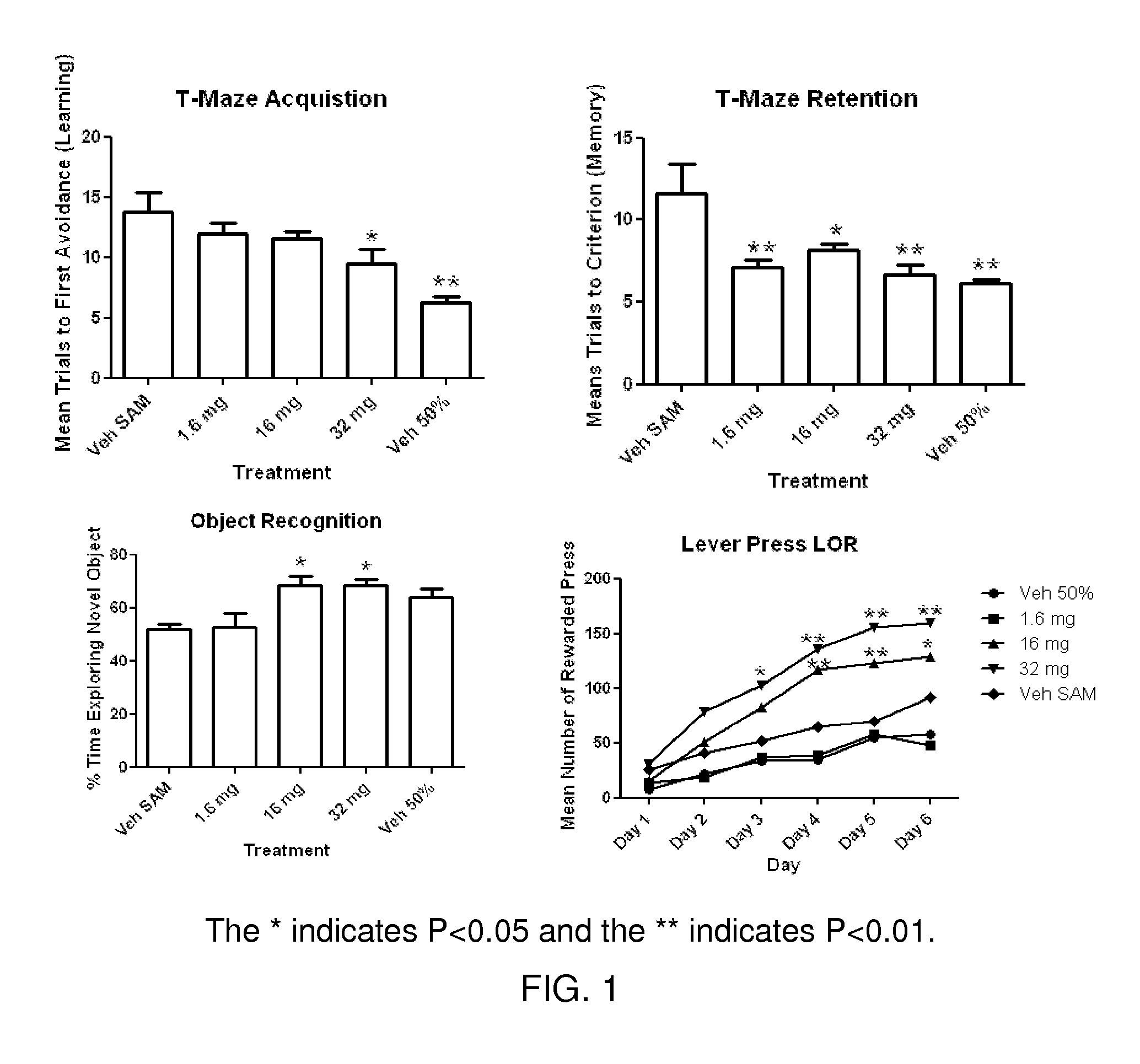Plant Extracts for Improving Cognitive Health and Function
- Summary
- Abstract
- Description
- Claims
- Application Information
AI Technical Summary
Benefits of technology
Problems solved by technology
Method used
Image
Examples
example 1
[0036]Oxidative damage is considered one of the hallmarks of the aging process [Harman D (2002) Alzheimer's disease: role of aging in pathogenesis. Ann N Y Acad Sci. 959, 384-395]. The neuronal dysfunction present in diseases associated with aging such as Alzheimer's disease is thought in large part to be from oxidative stress [Markesbery W R (1997) Oxidative stress hypothesis in Alzheimer's disease. Free Radic Biol Med. 23, 134-147; Polidori M C, Griffiths H R, Mariani E, Mecocci P (2007) Hallmarks of protein oxidative damage in neurodegenerative diseases: focus on Alzheimer's disease. Amino Acids. 32, 553-559]. Both structural and functional damage to mitochondria is present in Alzheimer's disease suggesting that antioxidants that easily penetrate both the cell and the mitochondria will provide the greatest protection from oxidative stress [Skulachev V P, Anisimov V N, Antonenko Y N, Bakeeva L E, Chernyak B V, Erichev V P, Filendo O F, Kalinia N I, Kapelko V I, Kolosova N G, Kopin...
example 2
90-Day Toxicity Study of Carnosic Acid
[0091]The purpose of this study was to evaluate the toxicity of the test article, a suspension (in sunflower oil) of rosemary extract containing approximately 10% carnosic acid (the active ingredient), when administered once or twice daily via oral gavage to rats for at least 90 days.
[0092]Male and female Hsd:Sprague Dawley SD rats were assigned to groups, and doses were administered as indicated in the following table. Animals were dosed via oral gavage.
No. ofCA Dose LevelaCA DoseAnimalsa(mg / kg / (mg / kg / ConcentrationbGroupMaleFemaledose)day)(mg / mL)1 (Control, BID1010000dosing)c2 (Low, BID101032.5656.5dosing)3 (Mid, BID dosing)10106513013.04 (Mid, SID dosing)101013013013.05 (High, BID10109018018.0dosing)CA = Carnosic acid; the active ingredient in the test article.BID = Twice daily; doses on each day were administered approximately 6 hours apart (based on last animal dosed / sex / group).SID = Once daily.aAnimals were dosed at 10 mL / kg / day; doses for ...
example 3
90-Day Toxicity Study of Rosmarinic Acid
[0095]The purpose of this study was to evaluate the toxicity of the test article, a dry extract of rosemary containing approximately 15% (w / w) rosmarinic acid (the active ingredient) dissolved in distilled water, when administered once daily via oral gavage to rats for at least 90 days.
[0096]Male and female Hsd:Sprague Dawley SD rats were assigned to groups, and doses were administered as indicated in the following table. Animals were dosed via oral gavage.
RA DoseNo. of AnimalsaRA Dose LevelaConcentrationGroupMaleFemale(mg / kg / day)(mg / mL)1 (Control)b1010002 (Low)1010656.53 (Mid)1010130135 (High)101030030RA = Rosmarinic acid; the active ingredient in the test article.aAnimals were dosed at 10 mL / kg / day.bGroup 1 received vehicle control article (distilled water) only.
[0097]Assessment of toxicity was based on mortality, clinical signs, body weight, body weight change, food consumption, ophthalmic examinations, functional observation battery (FOB),...
PUM
| Property | Measurement | Unit |
|---|---|---|
| Frequency | aaaaa | aaaaa |
| Frequency | aaaaa | aaaaa |
Abstract
Description
Claims
Application Information
 Login to View More
Login to View More - R&D
- Intellectual Property
- Life Sciences
- Materials
- Tech Scout
- Unparalleled Data Quality
- Higher Quality Content
- 60% Fewer Hallucinations
Browse by: Latest US Patents, China's latest patents, Technical Efficacy Thesaurus, Application Domain, Technology Topic, Popular Technical Reports.
© 2025 PatSnap. All rights reserved.Legal|Privacy policy|Modern Slavery Act Transparency Statement|Sitemap|About US| Contact US: help@patsnap.com



